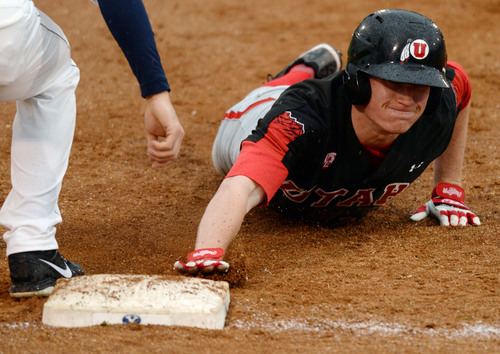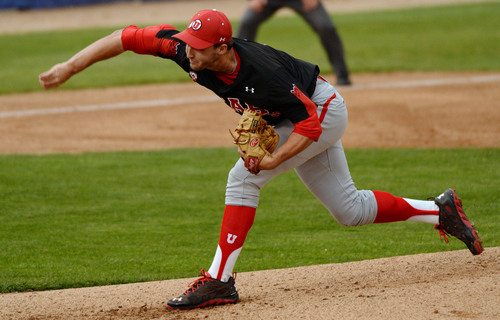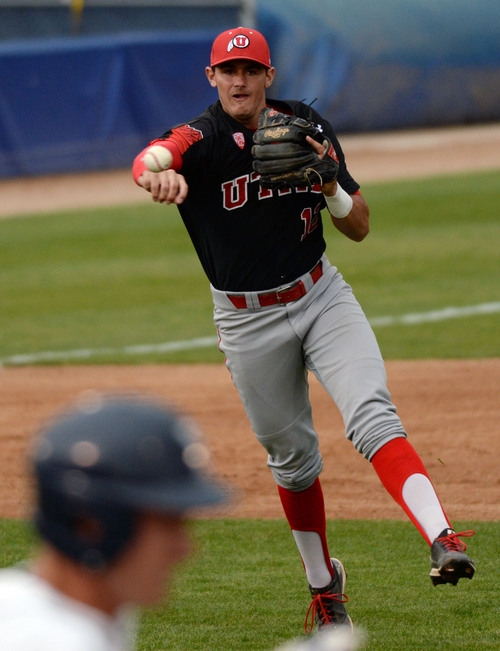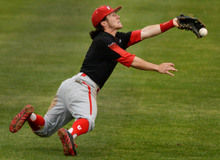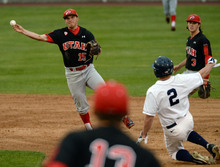This is an archived article that was published on sltrib.com in 2014, and information in the article may be outdated. It is provided only for personal research purposes and may not be reprinted.
Head coach Bill Kinneberg thought this was it, The Leap.
The Utes had finished the 2013 campaign on a high note, winning four of their last six and capping the season with a win against No. 7 Oregon. They'd had a great fall. Most of their staff remained in tact.
And yet.
And yet here, a few months later, Utah is once again last in the Pac-12.
At 4-20, they've been outscored 138 to 74. They're hitting .205 to their opponents' .294. In conference games, they rank last in on-base percentage, slugging percentage, hits, RBIs and earned run average.
Kinneberg, clear-eyed, refuses to blame luck. Injuries to Braden Anderson, Dallas Carroll, Tyler Yagi and A.J. Young have exacerbated their struggles, he says, but injuries are not uncommon.
It simply means that his job is not yet done.
"I knew what we were getting into," says Kinneberg, who coached at Arizona for five seasons and Arizona State for two seasons. "I knew the quality of the teams that we were going to compete against each weekend, and what a jump that was from the Mountain West or the WAC. There was a player-to-player difference."
How, then, does Utah get over the hump? More: Is any hump as steep?
The U. has charged its Rocky Mountain program with competing in places where the worst of winter can be described as "brisk," where baseball is king among preps, and where cozy on-campus stadiums offer players a sense of ownership and fans a lively atmosphere.
So far, the best they can manage against that is 18-66.
—
Snow problem? • Kinneberg insists there's very little the Utes can't do during their 132-day allotment that other teams can.
That doesn't mean life on the Wasatch isn't harder than elsewhere.
The Utes travel nonstop from February to mid-March, an exhaustive stretch for a team trying to hone its swings, motions, dives and what have you. They even drive to St. George on weekends for preseason work.
Senior catcher Konnor Armijo concedes that practicing indoors at the Spence Eccles Field House, "hinders our ability — not being outside when USC and UCLA can get outside year-round and work on more stuff." So the Utes control what they can control and pride themselves on their attention to detail in small-ball situations, Armijo says.
Colorado, Utah's Pac-12 classmate, doesn't field a baseball program. Pac-12 Network analyst Kevin Stocker says however that the success of teams like No. 1 Oregon State and No. 15 Oregon "dispels the myth" that quality and distance from the equator strictly correlate.
Kinneberg — who has led the Utes as far as the regional round of the NCAA Tournament in 2009 — agrees. The elements are a disadvantage, he says, but that's "never going to be an excuse for me."
—
No place called home • Most schools in the Pac-12 play in on-campus stadiums. Most are the lone tenants of their stadiums.
But not Utah.
The Utes draw just north of 1,000 fans per game, but at the downtown 15,400-seat Smith's Ballpark, 1,000 is more of a gang than a crowd.
Sophomore outfielder Kody Davis is the son of a former Ute (Troy Davis, 1983-86) and hopes for a return, someday, to the campus digs he watched them play on growing up.
Of Smith's, he says, "it's a great playing surface. The grounds crew takes care of us. But it would be nice to have a field on campus, where we would get more people out there to support us."
Armijo put it this way: "It can feel like we're playing away on our home field."
Kinneberg says visiting teams are uniformly wowed by the view and field conditions at Smith's, which he believes is "far and away" the best ballpark in the Western U.S.
Beggars couldn't choose better.
"But it's not ours," he admits. They aren't able to practice often at Smith's, and when the Bees are in town, they have to play earlier in the day.
Stocker adds that Pac-12 North schools have turf that allows them to brave snow and rain. Such a field might kill two birds for Utah.
—
State of players • The move to the Pac-12 has helped Utah "get its foot in some doors," so to speak.
Armijo, from Corona Calif., said that as a SoCal kid "you always dream of playing in the Pac-12."
He was also recruited out of Santa Ana College by Oregon, but only as a preferred walk-on, and he felt the Ducks were trying to sell him on swanky gear and not the brand of togetherness and kinship Kinneberg preached at the U.
So he's proof: Utah can win those out-of-state battles.
But in-state recruits go further.
Baseball teams get 11.7 full scholarships, and they can parse those out to as many as 27 players. In-state players require less aid, so for a team like the Utes that relies more commonly on out-of-state talent, it is hard to balance the scholarships as evenly some teams drawing from baseball-mad California or Arizona.
"Our team has to have a makeup of Utah kids, there's no doubt about that," Kinneberg says. "The state of high school baseball here is very important to us and BYU and Utah Valley, because the core of our clubs are going to come from this state."
Without Utah kids, it's tougher to foster depth because you can't offer scholarships to as many players. Stocker said that against Washington State on Sunday, "There was a point where [Utah] only had two guys on the bench that were healthy enough to come in."
—
Renewed hope • The U.'s starting lineup likely won't be hit too hard between graduations and the MLB draft in June, but they'll bid farewell to a handful of arms.
Zach Adams and Tanner Banks will be gone, and five freshman pitchers (should they all remain committed through the draft) will be asked to play central roles right away.
First, though, this year's Utes have six more Pac-12 games to best the 7-23 marks from Pac-12 seasons 1 and 2, and Tuesday night they'll try to even their season series against BYU at 2-2.
"I love this club and the fact that, there's not one day where they really haven't come out and practiced hard and played hard," Kinneberg says. "It's been hard. It's been tough on them."
Asked if next year could be the year of The Leap, he turns sheepish. Maybe he feels like a broken record.
But if truth be told, he says, it just might be.
"Are we where we want to be at this point? No. Can we get there? No doubt.
"It's going to take time." —
Pac-12 baseball standings
1. Oregon St. 20-4 38-8
2. Washington 19-5 36-11
T-3. Oregon 14-10 35-16
T-3. Arizona St. 14-10 26-21
5. USC 14-13 26-22
6. Wash. St. 12-12 22-24
7. Stanford 11-13 24-21
8. UCLA 10-14 23-25-1
9. Cal 9-15 21-25
10. Arizona 8-19 19-30
11. Utah 4-20 15-30 —
Utah vs. BYU
When • 7 p.m. Tuesday
Where • Smith's Ballpark
Series • BYU leads 2-1
TV • Pac-12 Network



